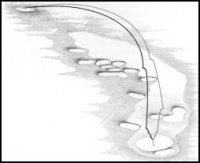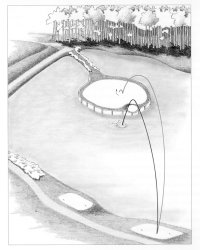|
The Library
How to Lower Your Score by Reading the Features of a Course Chapter 1: The Playing Field Design Styles: Strategic, Penal, and Heroic The terms “strategic,” “penal,” and “heroic” frequently are applied to shots, features, holes, and even entire courses. Because these shorthand references appear in various places in this book, it is important for you to understand how I will be using them. It is equally important to understand that these categories are not totally clear-cut in every case, and experts may disagree regarding which term best describes a specific hole, or feature. For me, a “strategic” hole is one that has at least one reasonable route for reaching the green in regulation with very little risk of incurring a severe penalty because of a misplayed shot. In addition, if there are several alternative routes, the route having the greatest distance generally has the least risk of incurring a severe penalty for a misplayed shot. A hole is “penal” if the only way to reach the green in regulation involves successfully executing at least one shot that will incur a severe penalty if misplayed. Often the severe penalty involves a ball lost in an escape-proof hazard like water, a ravine, or out-of-bounds. A “heroic” hole has at least two distinctly different alternatives for reaching the green in regulation. One lacks a severe penalty for a misplayed shot. With the second, however, a misplay incurs a severe penalty, but, if successfully negotiated, it will reward the player with a far superior position and/or distance advantage. Thus, the player faces a truly heroic decision. This shot itself also can be called heroic. Accomplished designers often blend strategic, penal, and heroic holes to create a golf course with a pleasing balance and rhythm, much in the same way that a composer constructs a symphony. Although well-versed players may vehemently disagree over which of the three categories a particular hole belongs to, it would be rare indeed to classify all holes on a given course as a strategic, penal, or heroic. Therefore, when an entire course is given one of these labels, it likely means that it has a relatively large number of holes of that particular type. Last, hazards are frequently referred to as being penal. This appellation simply indicate that the hazard is one from which escape is extremely difficult or impossible. Additionally, hazards can be classified as strategic. This label is usually applied to hazards that are well positioned and from which a full recovery shot is possible. You will never hear hazards being called heroic. I am sure that you have recognized that, in many ways, a heroic shot decision can be by far the most complex and nerve-racking. It represents the essence of great mental golf: a clear choice offering obvious but very different risks and rewards. Now that you have an idea of what a hole needs to have to be strategic, penal, or heroic, let’s look at examples of each type. The holes I have selected can clearly be placed in one of these three categories.
In conclusion, the designer orchestrates the hazards and other features into mental and physical playing challenges whose product is holes that are strategic, penal, or heroic.

|


